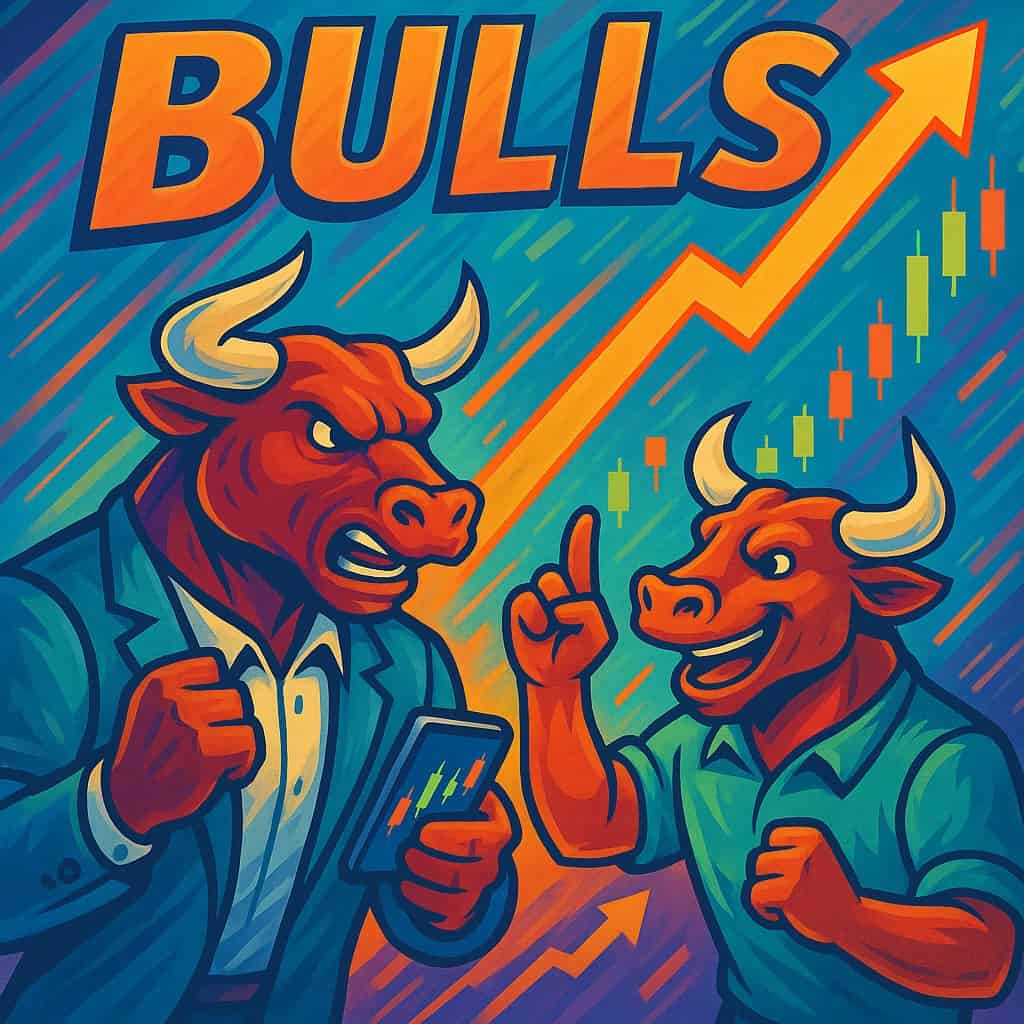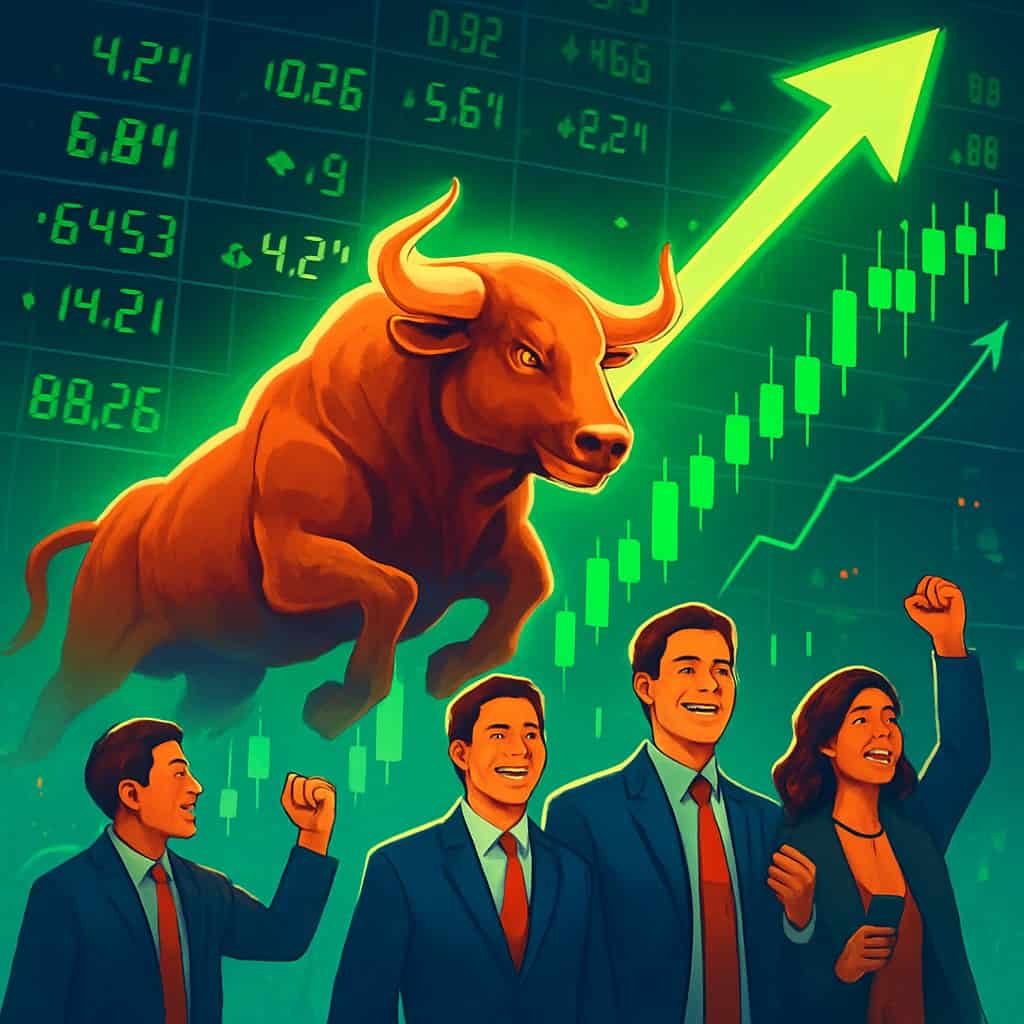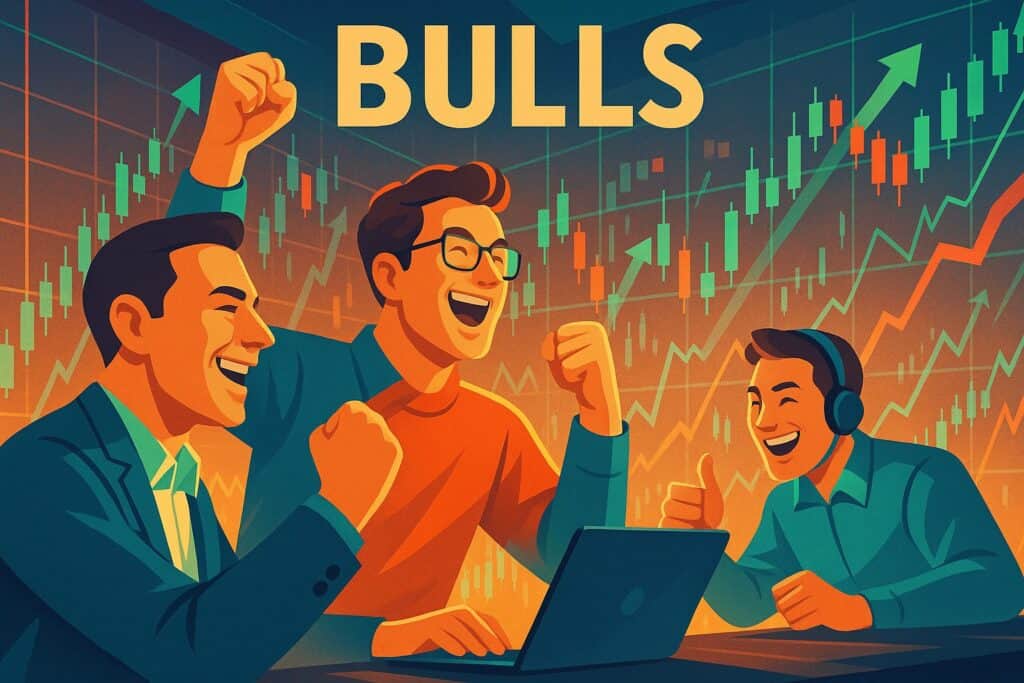Ever heard someone say, “The bulls are running the market today!” and wondered what that actually means? 🐂 If you’re hanging out in trading chats, scrolling through finance TikTok, or even just catching the news, “bulls” is a word you’ll see everywhere. But it’s not just about animals—it’s a whole vibe in the world of stocks, crypto, and investing. Let’s break down what “bulls” really means, why everyone’s obsessed with it, and how it became a staple in trading slang.
| What It Means | Why It Matters | Real-Life Example | Related Slang |
|---|---|---|---|
| Bulls are optimistic traders who expect prices to rise | Bulls drive buying sprees and market rallies | “The bulls are pushing Bitcoin up today!” | Bears, Bullish, Bull Market |
What Does “Bulls” Mean in Trading?
Bulls are the people who believe prices are going up. If you’re bullish, you’re basically betting that whatever you’re buying—stocks, crypto, sneakers, whatever—is about to get more valuable. Bulls are the opposite of bears, who think prices will drop. So, when you hear “bull market,” it means prices overall are climbing and people are feeling good about it.
- Bullish = Upward vibes: Expecting growth, gains, and green charts.
- Bearish = Downward vibes: Expecting losses or a drop in value.
- Bull run: When prices keep rising for a while, sometimes in a wild, unstoppable way.
If you want to see how other slang terms flip the meaning of a conversation, check out “sus” or “wrd”—they work in totally different contexts but show how a single word can change the whole mood.

Where Did “Bulls” Come From?
Here’s a cool bit of history: The terms “bull” and “bear” date back to the early 1700s in London. People noticed that bulls attack by thrusting their horns upward (just like prices going up), while bears swipe down with their paws (like prices dropping). The imagery stuck, and now it’s everywhere from Wall Street to your favorite meme account.
- Fun fact: The Wall Street Bull statue in NYC is a symbol of financial optimism and power.
- Cultural crossover: You’ll find “bulls” in crypto, stocks, and even sneaker reselling groups.
Bulls in Action: Real-Life Examples
Let’s get real—how do people actually use “bulls” in conversation?
- “Bulls are out in full force after that earnings call!”
- “I’m bullish on Ethereum this year—too many upgrades coming.”
- “Don’t get caught in a bull trap!” (That’s when things look good, but prices suddenly drop. Ouch.)
You’ll also see the 🐂 emoji or even 🚀 (“to the moon!”) when people are hyped about a price jump. Sometimes, there’s even a bit of friendly beef between bulls and bears in the comments section.
Variations & How Bulls Talk
Not all bulls sound the same. Some are loud and proud, spamming rocket emojis. Others are more chill, just quietly stacking their investments. Here’s what you might see:
- Crypto bulls: “Bitcoin to $100k, let’s goooo!” 🚀
- Stock market bulls: “Tech stocks are the move this quarter.”
- Bullish memes: Tons of animal pics, green arrows, and hype.
If you’re into how slang changes across cultures, check out our guides on Australian slang or New York slang—you’ll see how words like “bulls” fit into bigger language trends.

Bulls vs. Bears: Quick Comparison
| Bulls 🐂 | Bears 🐻 |
|---|---|
| Expect prices to rise | Expect prices to fall |
| Buy assets (“go long”) | Sell or short assets |
| Spread optimism | Spread caution |
| Love green charts | Love red charts |
Trends: When Do Bulls Take Over?
Bulls usually show up big time when markets are on the rise. Think about the insane hype during the GameStop saga or when Bitcoin was breaking records—those were classic “bull runs.” Everyone’s talking about “going to the moon,” and you’ll see a flood of bullish memes, rocket emojis, and wild predictions all over social media.
Noteworthy Bull Moments
- Meme Stock Mania: Remember when Reddit’s WallStreetBets sent GameStop soaring? That was a bull stampede.
- Crypto Surges: Whenever Bitcoin or Ethereum starts trending, bulls are everywhere, hyping up the next price milestone.
- Earnings Seasons: After a company drops a killer earnings report, bulls often rush in, pushing prices higher.
Bulls can sometimes get a little too hyped, though. That’s when you have to watch out for a “bull trap”—when it looks like prices will keep rising, but then they suddenly crash. It’s like thinking you’re about to win a race, only to trip at the finish line. Ouch.
Regional and Generational Vibes
The word “bulls” is pretty universal in trading, but how people use it can change depending on where you are or how old you are.
- Gen Z and Millennials: Love using emojis (🐂, 🚀) and phrases like “to the moon.”
- Older traders: Might just say “I’m bullish on Apple” and keep it moving.
- Crypto communities: Bulls are super vocal, often mixing in internet slang. Want to see how slang blends with finance? Check out what “gyat” or “bussin” mean outside the charts.
Related Terms Every Bull Should Know
If you’re going to talk like a pro, here are some must-know words that always pop up with “bulls”:
- Bull Market: A period where prices keep going up for months (or even years).
- Bullish: Feeling positive about future prices.
- Bull Trap: A fake-out where prices seem to rise, then crash.
- Going Long: Buying and holding, expecting prices to rise.
- Bears: The opposite of bulls—expecting prices to drop.
- To the Moon: When bulls think prices will skyrocket.
For more on how slang terms can totally change a convo, check out “wtw” or “istg”—they’re everywhere in online chats.
Pros & Cons of Using “Bulls” in Conversation
Let’s keep it real—using trading slang like “bulls” can make you sound in-the-know, but it’s not always the move.
Pros:
- Instantly shows you understand trading lingo.
- Helps you connect with other investors and traders.
- Makes convos more fun (who doesn’t love a good emoji?).
Cons:
- Can confuse people who aren’t into trading.
- Overusing it might make you sound like you’re just following the hype.
- Sometimes, bulls get too excited and ignore the risks (don’t be that person).
Expert Tips for Spotting and Using “Bulls”
- Watch for the Hype: If everyone’s suddenly bullish, be cautious—sometimes it means a correction is coming.
- Mix Up Your Slang: Don’t just say “bull” for everything. Try “bullish,” “bull run,” or even “bull trap” for variety.
- Stay Informed: Follow financial news and trading forums to see how bulls are moving. Want to keep your slang game strong? Check out “wyf” or “fysa” for more trending terms.
- Don’t Ignore the Bears: Sometimes, the bears have a point—balance is key.
Final Thoughts
Whether you’re just starting out or you’re deep into trading, knowing what “bulls” means (and how to use it) is a must. It’s more than just a word—it’s a whole mindset. Remember, every bull run eventually meets a bear, so keep your eyes open and don’t get caught up in the hype.
Want to dive deeper into internet slang? You’ll love our breakdowns of “lbvs”, “rsvp”, and even the 🤨 emoji. Trading or not, there’s always something new to learn!
Quick Recap Table
| Pro Bull Moves | Bullish Mistakes to Avoid |
|---|---|
| Connect with traders | Getting swept up in hype |
| Use the right slang | Ignoring market risks |
| Stay informed | Forgetting about the bears |
If you’re ever lost in a sea of slang, just remember: bulls are the optimists, always looking for the next big win. Happy trading! 🐂🚀
Stay tuned for the rest of the article, where we’ll dive into trends, expert tips, and the do’s and don’ts of using “bulls” in your trading convos! If you’re curious about misunderstood slang, don’t miss our guide on the most misunderstood emojis of 2024 🤔.







